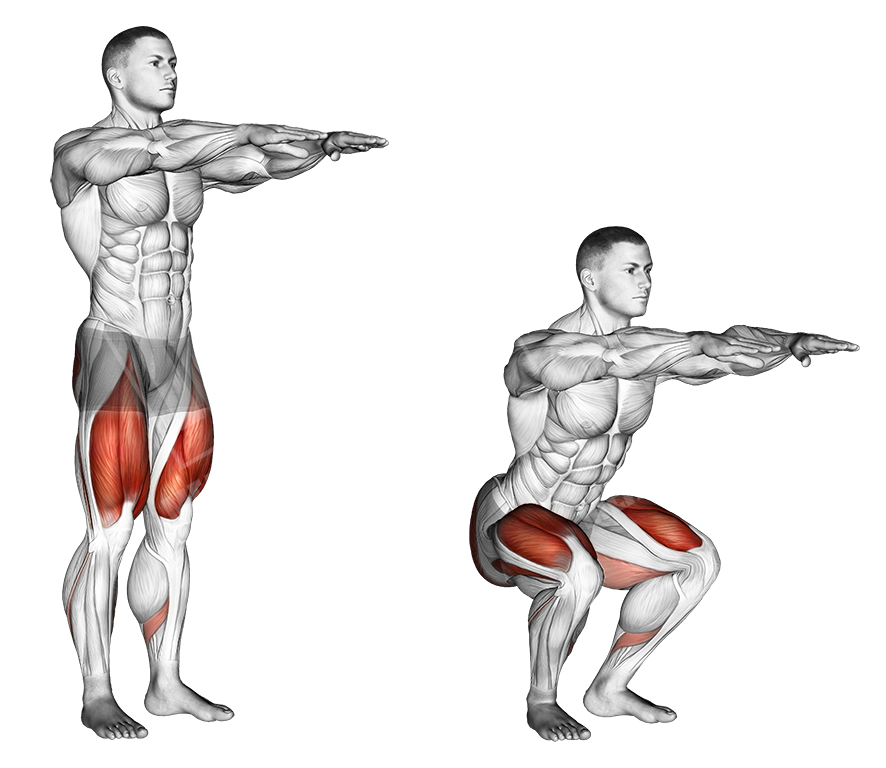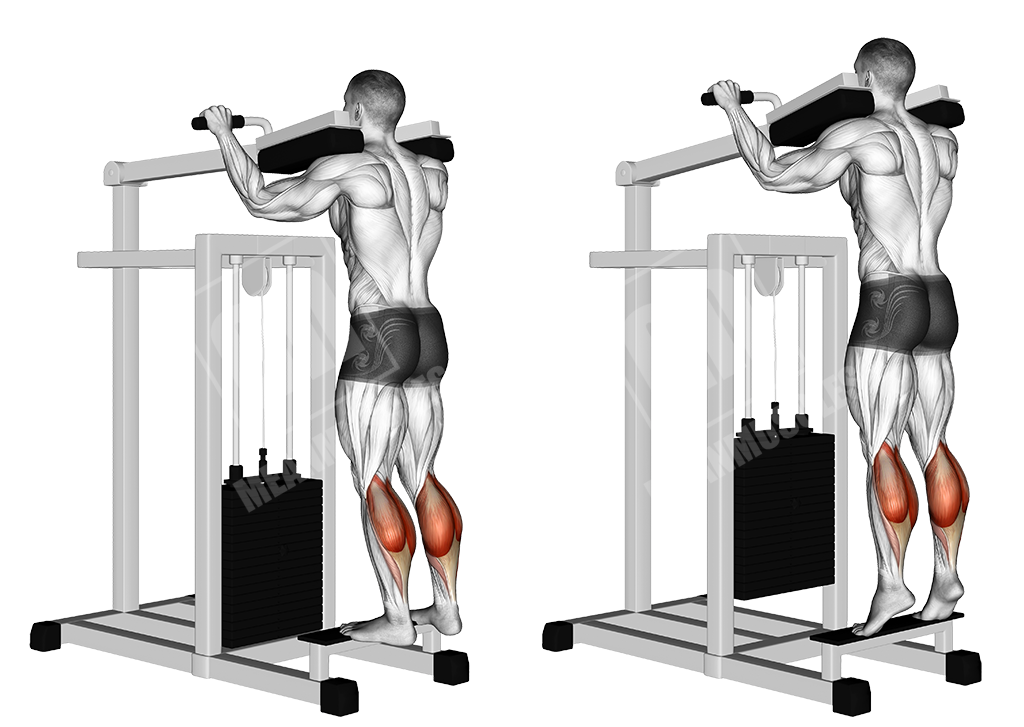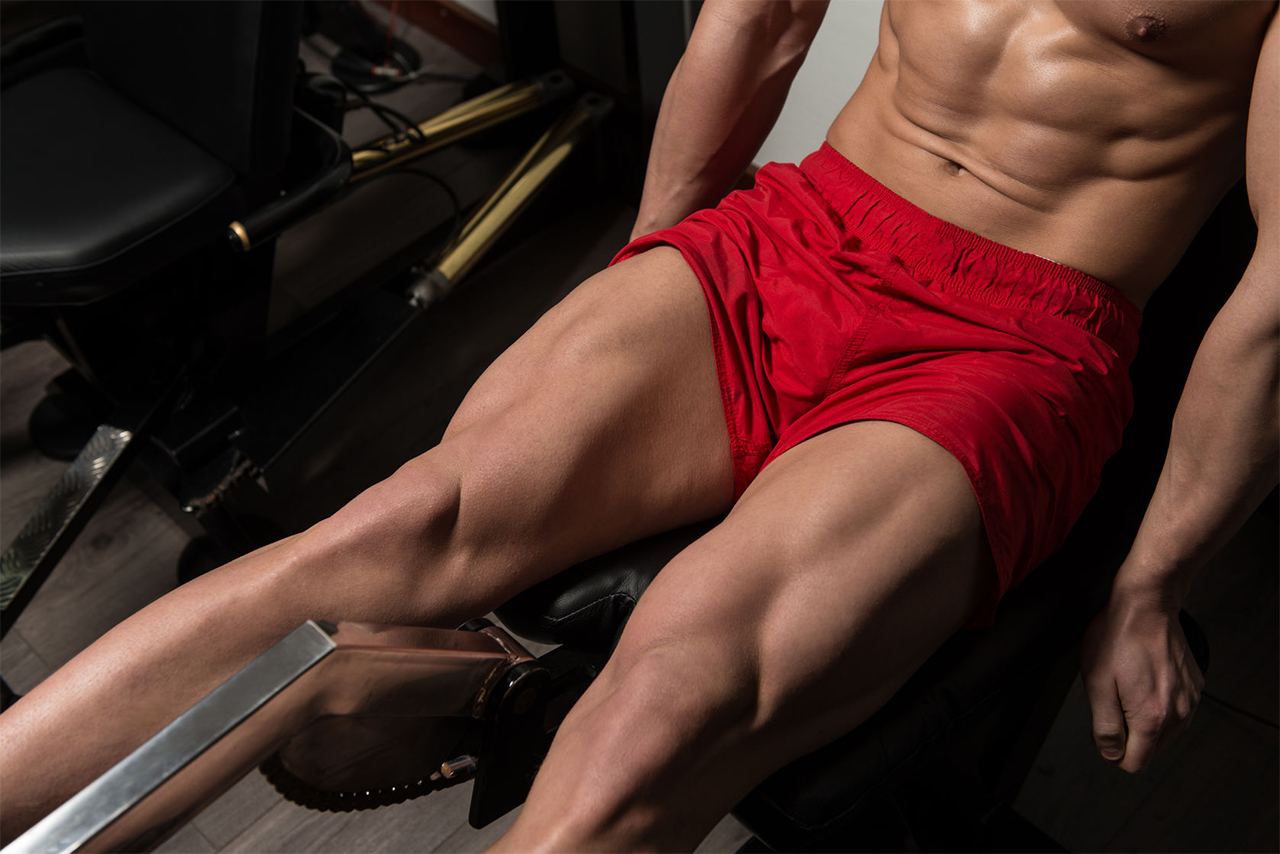This means that we will completely avoid answering the question “Should I train legs?” (because it is a MUST), and move on to the question “How should I train legs?”
Just as many of you, we have seen a lot of information regarding that question, online. Some of the information around structuring your leg day workouts is quite contradictory and different.
So, for example, some fitness websites will recommend higher volume, expressed through super-sets, others will say that squats over 15 reps are all we need.
However, the main point here is that those are the very websites that will not be able to tell you WHY you should use their recommendations.
Enough of the bashing, let’s get to the essence of it, and give you our best knowledge on lower body training, as well as a nice quadriceps-focused lower body workout.
Lower Body Structure
The main muscles that make up the lower body are the quadriceps, hamstrings, glutes, abductors and adductors, as well as the calf muscles.
The number of reps we need are inevitably related to the slow-to-fast muscle fibers ratio in the given muscle.
A reminder here – Slow muscle fibers are related to endurance and have a smaller hypertrophy capacity than the fast muscle fibers.
The slow muscle fibers are engaged in workouts with more than 15 repetitions.
On the other side, fast muscle fibers generate more strength and explosive power, for a shorter period of time, simply because they get exhausted quicker.
This is exactly why fast muscle fibers have a significantly bigger hypertrophy potential, compared to slow muscle fibers.
Using 6 to 8 repetitions, we primarily engage the fast twitch muscle fibers.
Now that we have reminded ourselves some basic biomechanics, let’s see which type of muscle fibers are found in each separate muscle group in the lower body.
As you can probably tell by the name of it, the quadriceps is built out of 4 heads:
- Vastuslateralis – This is the outer head of your quadriceps, the ratio of slow-fast muscle fibers here is 40/60
- Vastusmedialis – This is the inner head of your quadriceps, often referred to as the “teardrop” – 55/45 ratio
- Vastus intermedius, rectus femoris – These are the two heads found in the middle of your quadricep, the ratio here is 35/65
Even more, the ~10 repetitions workouts will allow us to gain strength easier, which, will therefore increase the intensity of the mechanical overload- And as we know, progressive overload is the number 1 hypertrophy stimulus.
Now, we’re not telling you to completely neglect those slow muscle fibers- Adding a couple of high-rep working sets in your workout will not only smash those muscle fibers and predispose them to growth, but will also help the body stack metabolites, which is another factor, towards the type of growth called sarcoplasmic hypertrophy.
The most effective quadriceps exercises are- Barbell squats, hack squats and leg presses.
Squats are the exercise that engages more muscle groups to a certain extent, but the most effective exercise, that directly stimulates all four heads of the quadriceps, is the hack squat.
Some people may love isolated movements like leg extensions, but we will just tell you that those are not the true muscle-builders and the focus should be on compound movements.
The Workout
As you should know by now, for this workout, we will be focusing primarily on compound movements, that target the four heads of the quadriceps.
The workout begins with a 10-15 minute warm up, consisting of light cardio, stretching and going through the working muscle groups’ range of motion.
| Exercise | Number of Sets | Number of Repetitions | Muscle Groups Involved |
|---|---|---|---|
| Bodyweight squats | 3 | 12+ | Primarily quadriceps, secondarily hamstrings and glutes |
| Barbell bench squats | 5 | 10 | Primarily quadriceps, secondarily hamstrings and glutes |
| Leg presses | 3 | 8-10 | Quadriceps, hamstrings, secondarily glutes |
| Hack squats | 3 | 12+ | Primarily quadriceps, secondarily hamstrings and glutes |
| Lying hamstring curls | 5 | 10 | Hamstrings isolated |
| Straight leg calf raises | 5 | 10 | Calves |
| Seated calf raises | 4 | 15+ | Outer calf musculature |
The Exercises
Bodyweight Squats

This exercise will be considered warm up, before moving on to working sets with significantly heavier weight.
Execution
- Step with your feet at shoulder width (if you are tall, slightly wider than shoulder width)
- Toes are pointing slightly outward
- Keep lower back straight
- Place your hands crossed on your shoulders, or keep them straight as illustrated
- Keep the knees slightly bent
- Let your butt down, until the legs are parallel to the ground
- Move up, getting the tension through the heels to engage the quadriceps optimally
- Do not lock out the knee at the top, keep it bent and maintain as much tension as possible, upon the working musculature
Barbell Bench Squat

Execution
- Un-rack the bar and step with your feet at shoulder width and the toes opened slightly, so that they are not pointing forward- Step in front of the bench at such a distance, that will allow your butt to touch the bench at the bottom of the movement
- Keep your knees slightly bent and your back straight
- Squat down and slightly touch the bench with your butt (Short pause can be done at the bottom, but DO NOT sit down on the bench- Keep constant tension.)
- Move up, without locking your knees out, but still focusing on muscle contraction and constant tension
Leg Press

This is your next quad-blaster, which, some say is even more effective than squats, but in our humble opinion, this may vary from person to person.
Execution
- Lay down on the seat
- Keep your lower back and butt tight on the seat, so that your body won’t move during the movement
- Raise your legs on the platform
- Place them like you would in a squat stance, but slightly wider
Note
Toes are pointing to the sides slightly. Depending on your height and length of your legs, you may need to place your feet higher on the platform, in order to take the pressure off of the knees.
- Keep your knees slightly bent, without locking them out
- Let the weight down slowly, then push up explosively. Again, no knee lockout
Full Hack Squat

This is a variation of the squat movement, done on a sled, which is under an angle and allows you to squat in a fixed range of motion.
Execution
- Step on the platform and get under the pads
- Place your feet like you would during a normal squat
- Make sure to stick your back to the backrest
- Keep the knees slightly bent
- Squat down slowly, until the point where your legs are below parallel (full squat)
- Push up explosively, while still maintaining tension on the quads
Lying Leg Curl

Now that we have blasted the quads and warmed up their antagonist- The hamstrings, we can move on to isolated work for the back side of the leg musculature.
Execution
- Lay down on the machine (Sounds hardcore, doesn’t it?)
- Place your feet under the pad, so that it is slightly above the heel- Keep legs at shoulder width
- Grab the handles
- Keep your back straight and tense the hamstrings
- Curl, until your hamstrings are fully contracted- Avoid having the pad touch your glutes
- Let your legs down slowly, while maintaining constant tension- Avoid letting the weight all the way down
If done with proper weights, the workout will exhaust both the quadriceps and hamstring musculature, but significantly higher fatigue will be felt in the front part of your legs.
Now to the calves- Oh, yes, one of those stubborn muscle groups for many people.
Calf Structure
The calves are made out of:
- Gastrocnemius, which makes up a bigger part of the calf, as it has two muscle heads, the slow/fast muscle fibers ratio here is 45/55
- Soleus- This is the muscle on the side of the calves, the ratio here is 90/10
Simply because the first is primarily made of fast muscle fibers, we consider that it is reasonable to train it primarily within the ~10 rep range with heavier weights.
The tempo however, is made out of 3 parts-
- Negative- Let the heel down slowly, below the ledge, stretching the calves- This part takes up to 3 seconds
- Positive- Moving up to the full contraction of the calves, takes 2 seconds before the peak contraction
- Isometric- Peak contraction, lasts for 1 second (pause)
Notes
The controlled negative of the movement stimulates a lot of the fast muscle fibers.
To focus on the gastrocnemius, we need to complete the calf raise in a position, where our legs are straight, as seated calf machine raises, where the knee angle is completely different, leads to a higher stimulation of the soleus, which, requires higher repetitions, due to the amount of slow muscle fibers it is made out of.
Now let’s get through each separate movement.
Straight Leg Machine Calf Raises

Execution
- Step on the ledge and get your shoulders below the pad
- Keep your knees very slightly bent, so that they are not locked out
- Let the heels down, below the ledge slowly
- Push up with a controlled movement, taking 2 seconds, and then a 1 second pause during the peak contraction of the calf musculature
- Proceed to the next negative, slowly letting your heels down
Seated Calf Machine Raises

Execution
- Sit down
- Place your legs under the pads
- Keep feet at shoulder width, standing on your fingers- Knee is at a 90-degree angle
- Again, follow the tempo pattern- 3 sec negative, 2 sec contraction, 1 sec peak contraction, repeat
Note – check our “Calves Priority Workout”

